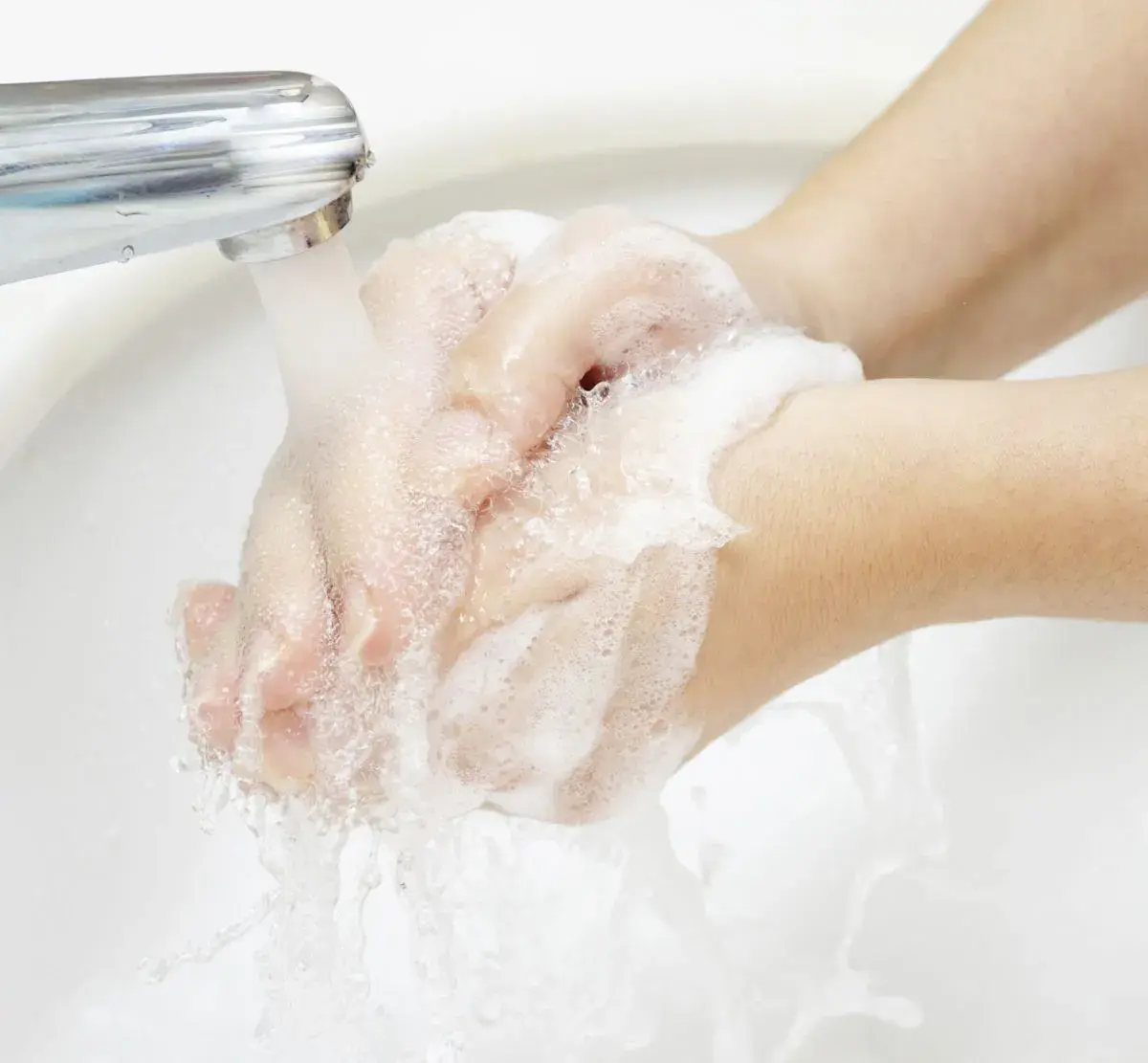A cleanroom creates special conditions for highly demanding processes and products. Employees are the decisive factor for the hygiene status of cleanrooms – and the most common cause of contamination. Therefore, correct behavior in and around the cleanroom is particularly important and strict rules of conduct must be observed at work. If the background is known, the understanding and thus the willingness to comply with these rules increases. Practical examples help in this respect.
The rules of conduct described below represent a selection of behavioral errors frequently observed in practice or worthy of discussion, without claiming to be exhaustive.
Personal hygiene
All persons entering a cleanroom are subject to strict hygiene rules in order to reduce the risk of contamination as far as possible. This importance of personal hygiene should therefore be clearly communicated and put into practice. Here, the contribution of each individual counts, because in the end, a sum effect takes place in the cleanroom. Thus, working in the cleanroom is always a team effort.
In terms of personal hygiene, the focus is on body hygiene, and here especially on hand hygiene. If possible, no body care products, cosmetics, etc. should be applied before cleanroom work. Drugstore articles should be applied before cleanroom work. This applies to both hair and skin. The guiding principle here is clearly: less is more! After all, working in the cleanroom is not about looking good. Consequently, the following applies to hands and faces: pure nature. The trend towards nail design and eyelash extensions must be resisted.

Jewelry in the cleanroom
Consistency also pays off when it comes to banning visible jewelry, because particles and microorganisms adhere to it. In addition, movement causes friction and thus material and skin abrasion. This also applies to jewelry worn under the glove. This makes the question of when to put on the first pair of gloves more important. Aren't you already in the personnel lock? There is also the question of whether the finger ring might damage the glove. Another issue is occupational safety at this point. All this clearly speaks against wearing jewelry in the cleanroom.
Cleanroom clothing
For the cleanliness requirements in the cleanroom, the cleanroom clothing, including the correct handling and the associated gowning, plays an important role. After all, cleanroom clothing is the only barrier between the human particle and germ sling and the cleanroom. In practice, correct dressing is always a challenge, especially for the cleanroom overall and sterile gloves.

Intensive training and practice are therefore required. If even one leg of the overall falls to the floor because the fabric can be very slippery, it is a case for the laundry and a new overall is needed. In the right size, of course, because otherwise there is a risk of the so-called pump effect. This is an uncontrolled release of contaminants from the collar area during a rapid downward movement, so that the coverall tightens around the body.
Controlled movements
This brings us to these mnemonics: Please move slowly and in a controlled manner. Avoid fast and hectic movements. This applies to all cleanroom activities, including cleaning. Stress or haste and the cleanroom are not compatible.
This is due to the special airflow in the cleanroom. Ideally, the maximum amount of clean air enters the room via the ceiling and leaves it as close to the floor as possible. As a result, contaminants of any kind are always pushed down to the floor and accumulate there. If cleanroom personnel now walk too fast, these contaminants are stirred up again. This also has a negative effect on the airflow in the room.
Airflow in the clean room
The designed airflow of the cleanroom and airlock should be influenced as little as possible by the activities and machines in the cleanroom. A common mistake is when exhaust air openings are partially or even completely obstructed. After all, a trolley or other cleanroom interior, such as a table, must be placed somewhere. There is usually space in front of the exhaust air opening to put things down. However, this is not a good idea for the reasons described. For optimal removal of all airborne contaminants, there should also be no horizontal surface above the exhaust vent. Trash cans or similar should not be placed right next to it.
Coughing and sneezing
The subject of coughing and sneezing in the cleanroom is often the subject of controversial discussions. Is it permissible to prohibit these physiological reactions to chemical or physical stimuli? Should they be suppressed? The regulations on this are up to the cleanroom operator. In any case, it makes sense to consider possible solutions to both problems, even though in practice people very rarely cough or sneeze in the cleanroom - provided they are healthy. One option would be to take cleanroom wipes and hold them quickly in front of the mouth and nose. All droplets should be trapped in the wipes at the latest, so it makes most sense to remove these wipes from the face and dispose of them only in the personnel airlock. All cleanroom clothing, in particular face masks, possibly eye slit hoods and gloves, must be changed after this action. This is followed by renewed gowning in accordance with the specifications of the relevant cleanliness class.
However, you may have just entered the cleanroom and can return to the personnel airlock by a short route to finish coughing and/or sneezing. Thus, your aerosol does not enter the cleanroom at all. If left unchecked or without a mouthguard or similar, the ejecta consisting of glycoproteins, cell debris, minerals, bacteria and viruses would be distributed over a distance of approx. 5 - 8 meters.
Not suitable for the cleanroom is the widespread rule of coughing or sneezing into the crook of the arm due to the Corona virus. This may be justified in public, but we are after all in a special environment, namely the cleanroom. In fact, no arm pit is really tight. If you sneeze or cough into it, aerosol will get past the top and bottom of your arm and into the room. In addition, the sputum would subsequently be on the outside of the cleanroom clothing. Microorganisms and particles would then be blithely carried through the cleanroom - even if you went directly to the personnel airlock after coughing and sneezing.

Scratching
A common behavioral mistake is also scratching. Who does not know that? It itches on the head or face and already the hand is on the way to counteract it. The first hurdle to become aware of at this point is the conscious awareness of this automatism of the body. The second hurdle is self-control. If one cannot or does not want to oppose this stimulus, one goes by the shortest route to the personnel lock. There you can scratch. This procedure is also recommended for corrections that have to be made to the cleanroom clothing for various reasons. This also includes a brief tug on the mouth guard or safety goggles. Skin particles and hair do not belong in the cleanroom. However, anyone familiar with cleanroom cleaning will certainly have already found and removed the hair in the cleanroom. And with it, of course, particles and microorganisms.
First-Air-Effekt
One behavioral error that should be applied to all activities in airlocks and cleanrooms is the so-called first-air effect. The rule is: Do not lean over the process/product/cleaned or disinfected surfaces. Otherwise, the specific airflow in the premises will cause contamination to be blown off by the cleanroom personnel and travel directly to where it is not supposed to go, thus posing a hazard to the product. It always becomes especially critical when there is a human being at the end of the value chain who wants to get well.
Number of people in the airlock and cleanroom
The question also arises as to how many people may be in the airlock and cleanroom at the same time. Do the cleanroom personnel know these numbers? Where are these figures written down or, in the simplest case, can they be read on site? Are there language barriers among the personnel or is everyone able to read and understand German texts? This is usually determined by the cleanroom manager and regularly monitored by particle measuring devices and must be communicated and known to the employees.
Finally, let us list supposedly self-evident things in cleanroom work:
- No smoking, eating and drinking. This includes chewing gum and sucking candy.
- No personal items that are not really needed for the activity in the cleanroom (exceptions are body-hugging aids, e.g. glasses, hearing aids, etc.).
- The sit-over bench is so named because it is meant to sit on it.
- Same rules for everyone. There are absolutely no exceptions.
- An illustrated lock order should be available.
- Regular training of all persons who want to enter the cleanroom, however briefly, is mandatory.
- Do all employees know cleanroom-appropriate postures, such as penguin, robot or pharaoh?
- Do not cross your arms, do not lean or support them, otherwise there is a risk of contamination transfer.